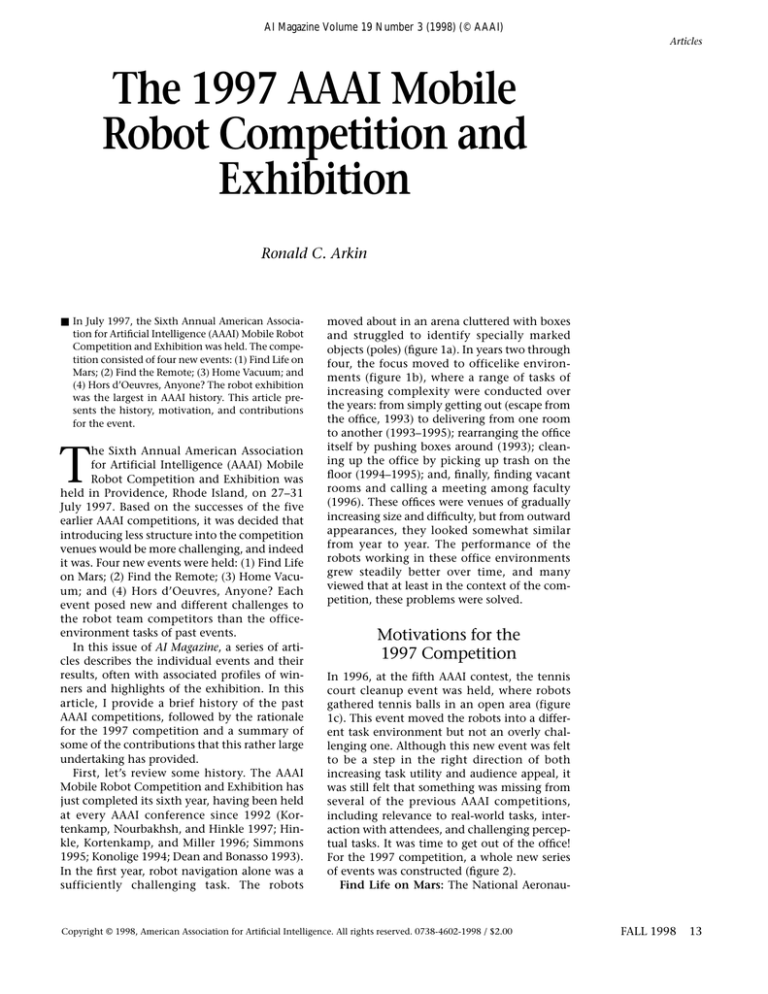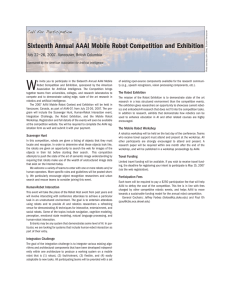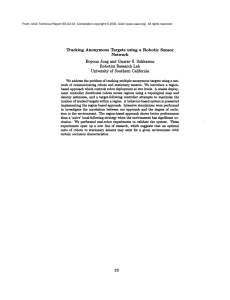
AI Magazine Volume 19 Number 3 (1998) (© AAAI)
Articles
The 1997 AAAI Mobile
Robot Competition and
Exhibition
Ronald C. Arkin
■ In July 1997, the Sixth Annual American Association for Artificial Intelligence (AAAI) Mobile Robot
Competition and Exhibition was held. The competition consisted of four new events: (1) Find Life on
Mars; (2) Find the Remote; (3) Home Vacuum; and
(4) Hors d’Oeuvres, Anyone? The robot exhibition
was the largest in AAAI history. This article presents the history, motivation, and contributions
for the event.
T
he Sixth Annual American Association
for Artificial Intelligence (AAAI) Mobile
Robot Competition and Exhibition was
held in Providence, Rhode Island, on 27–31
July 1997. Based on the successes of the five
earlier AAAI competitions, it was decided that
introducing less structure into the competition
venues would be more challenging, and indeed
it was. Four new events were held: (1) Find Life
on Mars; (2) Find the Remote; (3) Home Vacuum; and (4) Hors d’Oeuvres, Anyone? Each
event posed new and different challenges to
the robot team competitors than the officeenvironment tasks of past events.
In this issue of AI Magazine, a series of articles describes the individual events and their
results, often with associated profiles of winners and highlights of the exhibition. In this
article, I provide a brief history of the past
AAAI competitions, followed by the rationale
for the 1997 competition and a summary of
some of the contributions that this rather large
undertaking has provided.
First, let’s review some history. The AAAI
Mobile Robot Competition and Exhibition has
just completed its sixth year, having been held
at every AAAI conference since 1992 (Kortenkamp, Nourbakhsh, and Hinkle 1997; Hinkle, Kortenkamp, and Miller 1996; Simmons
1995; Konolige 1994; Dean and Bonasso 1993).
In the first year, robot navigation alone was a
sufficiently challenging task. The robots
moved about in an arena cluttered with boxes
and struggled to identify specially marked
objects (poles) (figure 1a). In years two through
four, the focus moved to officelike environments (figure 1b), where a range of tasks of
increasing complexity were conducted over
the years: from simply getting out (escape from
the office, 1993) to delivering from one room
to another (1993–1995); rearranging the office
itself by pushing boxes around (1993); cleaning up the office by picking up trash on the
floor (1994–1995); and, finally, finding vacant
rooms and calling a meeting among faculty
(1996). These offices were venues of gradually
increasing size and difficulty, but from outward
appearances, they looked somewhat similar
from year to year. The performance of the
robots working in these office environments
grew steadily better over time, and many
viewed that at least in the context of the competition, these problems were solved.
Motivations for the
1997 Competition
In 1996, at the fifth AAAI contest, the tennis
court cleanup event was held, where robots
gathered tennis balls in an open area (figure
1c). This event moved the robots into a different task environment but not an overly challenging one. Although this new event was felt
to be a step in the right direction of both
increasing task utility and audience appeal, it
was still felt that something was missing from
several of the previous AAAI competitions,
including relevance to real-world tasks, interaction with attendees, and challenging perceptual tasks. It was time to get out of the office!
For the 1997 competition, a whole new series
of events was constructed (figure 2).
Find Life on Mars: The National Aeronau-
Copyright © 1998, American Association for Artificial Intelligence. All rights reserved. 0738-4602-1998 / $2.00
FALL 1998
13
Articles
A
Photo Courtesy, NewtonLabs.
B
C
Figure 1. AAAI Mobile Robot Competition and
Exhibition over the Years.
A. FLAKEY among poles in 1992. B. Office layout used in 1994.
C. NewtonLabs entry fetching tennis balls in 1996.
14
AI MAGAZINE
tics and Space Administration Pathfinder Mission was scheduled to land on Mars a little less
than one month prior to the start of the competition. This event, coupled with the potential discovery of life on the planet based on
recently found meteorite fragments, seemed
natural to leverage into the competition. Based
on the earlier popularity and success of the
clean up the tennis court event, various “life
forms” were introduced into a rock-strewn
area, where the robots were tasked with finding these specially colored animate and inanimate objects and returning them to the planetary lander for analysis. The hope was that
technology produced for answering the
research questions posed by this event could
ultimately lead to better and more intelligent
generations of planetary rovers to succeed
Sojourner.
Find the Remote Control: This event was
motivated not by the organizers’ ineptitude at
retrieving these objects in their own homes
but, rather, by the goal of helping the physically challenged with the use of assistive robotics.
A homelike venue was created using rented
furniture in which a wide range of interesting
objects to be retrieved were to be scattered
throughout. This task was clearly the most difficult from a perceptual point of view, resulting, unfortunately, in few competitors willing
to take the challenge.
Home Vacuum: This event also operated in
a homelike world. Although companies such
as Electrolux are almost ready to market robotic home vacuum cleaners, this task posed far
more challenging problems than would be
found in these near-term commercial types of
system. The robots would need to respond to
the presence of humans, detect messes, and
perform a range of operations that would
require significantly more intelligence than
simple navigation and obstacle avoidance.
Hors d’Oeuvres, Anyone? One final event
recognized that in the past there was literally a
barrier between the conference attendees and
the robots. It was felt that it was time to mainstream the robots with people by allowing
them to interact with humans at the conference reception by serving hors d’oeuvres. This
event was very popular: The attendees had a
strong role in the judging process, and surprising things were learned about human-robot
interaction as a by-product, such as the limitations of touch screens and speech as effective
interface technology in a noisy cocktail party
environment and the difficulty of circulating
in a crowded room because of human reaction
to a robotic servant.
Obviously, no one expected the perfor-
A
Courtesy, Fred Martin
Articles
B
Courtesy, Fred Martin
C
Courtesy, Fred Martin
D
Figure 2. 1997 AAAI Mobile Robot
Competition and Exhibition Entries.
A. Home vacuum. B. Find life on Mars.
C. Find the remote. D. Hors d’oeuvres, anyone?
FALL 1998 15
Articles
The AAAI
competition
has, and
continues
to make,
significant
contributions
to the robotics
community
in general.
16
AI MAGAZINE
Figure 3. Competition Participants at the 1997 Awards Ceremony.
mance of the robots on these first-time events
to be as good as previous efforts in the earlier
office tasks simply because they were completely new. The lack of predictable structure
also complicated matters for the competitors.
There were also four events in three different
venues —twice as many as ever had been held
in the past at a single competition. The hope
was that of these many efforts, a few would
provide durable challenges for the years to
come. Indeed, this has happened because two
of the events—Find Life on Mars and Hors
d’Oeuvres, Anyone?—are being held at the
1998 competition.
On the noncompetitive side, the 1997
Mobile Robot Exhibition was the biggest in
the history of the event. There were live
demonstrations scheduled throughout the
day concurrent with the competition. Many
unique hardware and software ideas were displayed that are detailed by Holly Yanco in
“The 1997 AAAI Mobile Robot Exhibition,”
also in this issue. One goal was to have continual action in the event hall, so that long
lulls in robotic activity that had occurred in
times past could be avoided. The exhibition
contributed significantly to both the intellectual content and excitement of the overall
event.
The Competitors
A large number of organizations participated
in the competition and exhibition (figure 3).
The organizations are listed in table 1 with the
events that the team was associated with.
Contributions
The AAAI competition has, and continues to
make, significant contributions to the robotics
community in general. For the 1997 competition, contributions included (1) novel test
domains outside a research group’s own laboratory, which provides challenges to the generalizability and robustness of solutions developed for the events’ problem domains; (2) this
robot exhibition was the largest in AAAI history; (3) the most events in the history of the
competition were held; (4) the first interactive
event with the audience debuted; (5) the first
high school team at a AAAI competition
(Miamisburg High School) arrived with an
ancient HERO robot and valiantly tried to get its
system to compete but unfortunately could
not; and (6) certainly remarkable were the
experience and camaraderie gained by the
team members putting in incredibly long
hours, often all night long, readying their systems to work.
In the remainder of this issue, the reader will
Articles
Team
Brandeis University
Brown University
Colorado School of Mines
Dartmouth College
Georgia Institute of Technology
Iowa State University
Kansas State University
Kiss Institute
McGill University
Miamisburg High School
Michigan State University
Massachusetts Institute of Technology
Naval Research Lab
Northwestern University
Swarthmore College
TRACLabs
University of Arkansas
University of Minnesota
University of New Mexico
University of Texas at El Paso
University of Virginia
University of Waterloo
Mars
Find the Remote
✓
✓
✓
(✓)
Home Vacuum
Hors d’Oeuvres
Exhibition
✓
✓
✓
✓
✓
✓
✓
✓
✓
✓
✓
✓
(✓)
✓
✓
✓
✓
✓
✓
✓
✓
✓
✓
✓
✓
✓
✓
✓
✓
Table 1. AAAI-97 Robot Competition and Exhibition Participants (noncommercial teams).
(✓) denotes intent but inability to compete in the event because of hardware-software problems.
find articles describing in more detail each of
the individual events and their outcomes. The
technical approaches used by the various
teams can be found in the Proceedings of the
Fourteenth National Conference on Artificial
Intelligence; each group was allocated two
pages to describe its approach. Finally, an
overview of the highly successful robot exhibition is presented.
Hinkle, D.; Kortenkamp, D.; and Miller, D. 1996. The
1995 Robot Competition and Exhibition. AI Magazine 17(1): 31–45.
Konolige, K. 1994. Designing the 1993 Robot Competition. AI Magazine 15(1): 57–62.
Kortenkamp, D.; Nourbakhsh, I.; and Hinkle, D.
1997. The 1996 AAAI Mobile Robot Competition
and Exhibition. AI Magazine 18(1): 25–32.
Simmons, R. 1995. The 1994 AAAI Robot Competition and Exhibition. AI Magazine 16(2): 19–30.
Acknowledgments
I would like to thank the Defense Advanced
Research Projects Agency and AAAI for providing sponsorship for student scholarships to the
competition. Many thanks also to the event
coordinators (Pete Bonasso, Ian Horswill, Kurt
Konolige, and Reid Simmons), the coorganizers (Jim Firby, Holly Yanco, and Robin Murphy), the numerous judges, and the participants for their dedication in making the
competition a success.
References
Dean, T., and Bonasso, R. P. 1993. 1992 AAAI Robot
Exhibition and Competition. AI Magazine 14(1):
35–48.
Ronald C. Arkin received a Ph.D.
in computer science from the University of Massachusetts at
Amherst in 1987. He then assumed the position of assistant
professor in the College of Computing at the Georgia Institute of
Technology, where he is now professor and director of the Mobile
Robot Laboratory. Arkin’s research interests include
reactive control and action-oriented perception for
the navigation of mobile robots and unmanned aerial vehicles, robot survivability, multiagent robotic
systems, and learning in autonomous systems. His email address is arkin@cc.gatech.edu.
FALL 1998 17
Articles
Artificial Intelligence and Mobile Robots
Case Studies of Successful Robot Systems
Edited by David Kortenkamp, R. Peter Bonasso, and Robin Murphy
he mobile robot systems described in this book were selected from among the best available implementations by leading universities and research laboratories. These are robots that have left the lab and
been tested in natural and unknown environments. They perform many different tasks, from giving tours
to collecting trash. Many have distinguished themselves (usually with first- or second-place finishes) at various
indoor and outdoor mobile robot competitions.
Each case study is self-contained and includes detailed descriptions of important algorithms, including pseudo-code. Thus this volume serves as a recipe book for the design of successful mobile robot applications. Common themes include navigation and mapping, computer vision, and architecture.
T
6 x 9, 400 pp. $37.50, ISBN 0-262-61137-6
Prices higher outside the U.S. and subject to change without notice.
To order, call 800-356-0343 (US and Canada) or (617) 625-8569.
Distributed by The MIT Press, 55 Hayward, Cambridge, MA 02142
18
AI MAGAZINE




